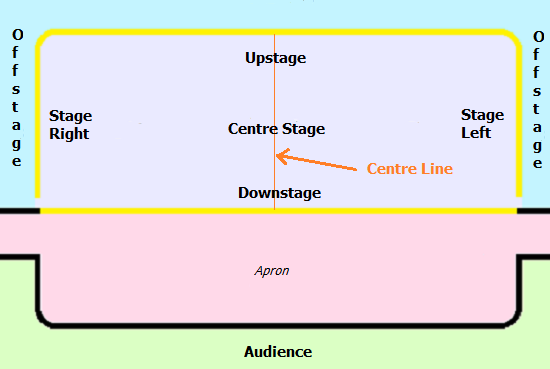Imagine being an actor rehearsing on stage and hearing this from the director ...
"Okay, I want you to move back a few steps and towards the left ... no, left from your point of view, not mine.
Then I want you to exit off to the side at the front of stage on the right hand side ... no, the right hand side from your point of view ..."
It would be very confusing, plus it would take a long time to get anything done in rehearsal!
To make sure that everyone involved in the production can communicate properly, the stage is divided into areas. Stage positions are always from the point of view of the performer when facing the audience.

Centre Stage
This is the middle of the performing area.
Centre Line
The centre line is an imaginary line which divides the stage exactly in half from the front of the stage to the back of the stage.
Upstage
This is the back of the stage. Stages in old theatres used to be raked, which meant that they were slightly sloped with the back higher than the front, so that the audience could see properly. The back of the stage was "up" compared to the front. This is why the back is called upstage.
Downstage
The front of the stage is known as downstage.
Stage Left
Stage left is the left hand side of the stage from the point of view of a performer standing on stage facing the audience. It is often called Prompt Side.
Stage Right
Stage right is the right hand side of the stage from the point of view of a performer standing on stage facing the audience. It is often called Opposite Prompt.
Onstage
This is the area of the stage which the audience can see.
Offstage
This is the part of the stage which is hidden from the audience.
Remember our confused director at the beginning of this article?
Using stage directions, he could have simply said ...
"Okay, I want you to move a few steps upstage left.
Then I want you to exit downstage right."
It's much easier when you know stage positions, isn't it?!